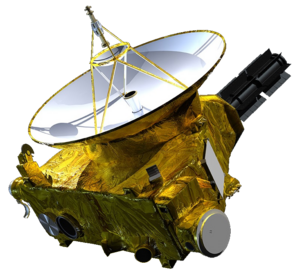New Horizons
New Horizons sī Bí-kok NASA ê thài-khong thàm-chhâ-ki (space probe), New Frontiers kè-ōe ê chi̍t pō͘-hūn. Thàm-châ-ki sī Johns Hopkins Tāi-ha̍k Èng-iōng Bu̍t-lí Si̍t-giām-sek (Johns Hopkins University Applied Physics Laboratory) kap Sai-lâm Ián-kiù-só͘ (Southwest Research Institute) chè-chō, chú-iàu ê jīm-bū sī tiāu-cha Mê-ông-chheⁿ.
 New Horizons chiap-kīn Mê-ông-chheⁿ ê khong-sióng-tô͘. | |||||||||||||||||
| Jīm-bū lūi-hêng |
Flyby (132524 APL · Jupiter ·Pluto ·486958 Arrokoth) | ||||||||||||||||
|---|---|---|---|---|---|---|---|---|---|---|---|---|---|---|---|---|---|
| Chhau-chok-chiá | NASA | ||||||||||||||||
| COSPAR ID | 2006-001A | ||||||||||||||||
| SATCAT № | 28928 | ||||||||||||||||
| Bāng-chām |
pluto nasa | ||||||||||||||||
| Jīm-bû keng-kòe sî-kan |
Primary mission: 9.5 years Elapsed: 18nî ,10goe̍h ,7kang | ||||||||||||||||
| Thài-khong-chûn sèng-chit | |||||||||||||||||
| Chè-chō-chiá | APL / SwRI | ||||||||||||||||
| Hoat-siā chit-liōng | 478 kg (1,054 lb)[1] | ||||||||||||||||
| Bû jiân-liāu chit-liōng | 401 kg (884 lb) | ||||||||||||||||
| Chài-mi̍h chit-liōng | 30.4 kg (67 lb) | ||||||||||||||||
| Chhùn-chhioh | 2.2 × 2.1 × 2.7 m (7.2 × 6.9 × 8.9 ft) | ||||||||||||||||
| Tiān-le̍k | 245 watts | ||||||||||||||||
| Jīm-bū ê khai-sí | |||||||||||||||||
| Hoat-siā ji̍t-chí | January 19, 2006, 19:00:00.221 UTC[2] | ||||||||||||||||
| Hóe-chìⁿ | Atlas V (551) AV-010[2] + Star 48B 3rd stage | ||||||||||||||||
| Hoat-siā tē-tiám | Cape Canaveral SLC-41 | ||||||||||||||||
| Chhéng-hù-chiá | International Launch Services[3] | ||||||||||||||||
| Kúi-tō chham-sò͘ | |||||||||||||||||
| Eccentricity | 1.41905 | ||||||||||||||||
| Inclination | 2.23014° | ||||||||||||||||
| Epoch | January 1, 2017 (JD 2457754.5)[4] | ||||||||||||||||
| Flyby of 132524 APL (incidental) | |||||||||||||||||
| Closest approach | June 13, 2006, 04:05 UTC | ||||||||||||||||
| Distance | 101,867 km (63,297 mi) | ||||||||||||||||
| Flyby of Jupiter (gravity assist) | |||||||||||||||||
| Closest approach | February 28, 2007, 05:43:40 UTC | ||||||||||||||||
| Distance | 2,300,000 km (1,400,000 mi) | ||||||||||||||||
| Flyby of Pluto | |||||||||||||||||
| Closest approach | July 14, 2015, 11:49:57 UTC | ||||||||||||||||
| Distance | 12,500 km (7,800 mi) | ||||||||||||||||
| Flyby of 486958 Arrokoth | |||||||||||||||||
| Closest approach | January 1, 2019, 05:33:00 UTC | ||||||||||||||||
| Distance | 3,500 km (2,200 mi) | ||||||||||||||||
| |||||||||||||||||
| |||||||||||||||||

New Horizons tī 2006 nî 1 goe̍h 19 tùi Tē-kiû chhut-hoat, 6 goe̍h 13 keng-kòe sió-he̍k-chheⁿ 132524 APL, 2007 nî 1 goe̍h 28 keng-kòe Bo̍k-chheⁿ liáu-āu chìn-ji̍p "khùn-bîn", 2015 nî 7 goe̍h 14 óa-kīn Mê-ông-chheⁿ.
Chiap-kīn Mêⁿ-ông-chheⁿ
siu-káiNew Horizons tī 2015 nî 1 goe̍h 4 ji̍t chiū khai-sí tùi Mêⁿ-ông-chheⁿ ê jīn-bū. I tī hit chūn hip liáu ka-ta chiàm kúi lia̍p pixel ê Mêⁿ-ông-chheⁿ siòng-phìⁿ. Kàu 1 goe̍h 15 ji̍t, NASA chèng-sek chiong thàm-chhâ-ki kái ji̍p "Mêⁿ-ông-chheⁿ Chiap-kīn" kāi-tōaⁿ[5].
2 goe̍h 12, NASA ko-pò͘ liáu 1 goe̍h 25 kàu 31 kî-kan só͘ hip ê sin iáⁿ-siōng, hit-chūn thàm-cha-kî lî Mêⁿ-ông-chheⁿ tāi-iok 203,000,000 kong-lí, siòng-phìⁿ tiong ē-tàng khoàn tio̍h Mêⁿ-ông-chheⁿ kap i-ê ōe-chheⁿ Charon.
Chham-khó
siu-kái- ↑ "New Horizons". NASA's Solar System Exploration website. December 1, 2022 khòaⁿ--ê.
- ↑ 2.0 2.1 Cleary, Mark C. (August 2010). Evolved Expendable Launch Operations at Cape Canaveral, 2002–2009 (PDF) (Report). Air Force Space & Missile Museum. 45th Space Wing History Office. p. 30. goân-loē-iông (PDF) tī 2020-01-03 hőng khó͘-pih. 2023-02-20 khòaⁿ--ê.
- ↑ "Atlas Launch Archives". International Launch Services. goân-loē-iông tī April 22, 2018 hőng khó͘-pih. April 21, 2018 khòaⁿ--ê.
- ↑ "HORIZONS Web-Interface". NASA/JPL. goân-loē-iông tī October 7, 2012 hőng khó͘-pih. July 25, 2016 khòaⁿ--ê. To find results, change Target Body to "New Horizons", Center to "@Sun", and Time Span to include "2017-01-01".
- ↑ New Horizons Begins First Stages of Pluto Encounter, New Horizons.
Guā-pōo liân-kiat
siu-kái- New Horizons website Archived 2023-02-13 at the Wayback Machine. by NASA
- New Horizons website by the Applied Physics Laboratory
- New Horizons profile by NASA's Planetary Science Division
- New Horizons profile by the National Space Science Data Center
- New Horizons Flyby of Ultima Thule – Best Places to Follow Future News.
- New Horizons Flyby – Musical Tribute by astrophysicist Brian May (who consulted on the project[1]) and the band Queen.
- New Horizons Mission Archive at the NASA Planetary Data System, Small Bodies Node
- New Horizons: Kuiper Belt Extended Mission (KEM) Mission Archive at the NASA Planetary Data System, Small Bodies Node
- ↑ "NASA Gets Some Help From Guitarist Brian May On Its New Horizons Probe", NPR, aired January 2, 2019.
